________________
[9]
In facts it is the majority of evidence or positive facts rather than that of opinions that should decide an issue. One has to be fair to one's problem; facts, whether favourable or unfavourable to one's conclusion, must be mentioned. No attempt should be made to suppress them because they upset one's preconceived conclusions. I am tempted to make these observations after reading what has been written by Muni Shri Vikramavijayaji on Mallavadi and Nayacakram, referred to below. Such tendencies in research will not yield abiding results; if we have no clear-cut evidence, let us not hazard speculations just because we want to stand by our conclusions at any cost.
Lately, the Dvadasaram, Nayacakram with the Nyayagamanusarini of Simhasuri has occupied the scholarly attention of a number of Jaina dignitaries. In 1952, the first part consisting of Four Aras edited by Muni Chaturavijayaji and Pt. Lalchar daji was published in the Gaekwad's Oriental Series, No. cxvi. A little earlier than that started appearing an edition of it by Shri Vijayalabdhisuri which is now completed in four parts published from Chani (Part I, 1948; Part II, 1951; Part III, 1956; and Part IV, 1960 which has an informative Foreword by Shri Vikramavijayaji). In all such work every edition has its value: critical editing and research pursuits, if systematically carried out, are all progressive efforts towards perfection. The present edition by Muni Shri Jambuvijayaji has its own specialities by which it marks a definite improvement on earlier efforts, and therefore, deserves all our appreciation. On comparison one finds that Shri Jambuvijayaji has a closer study of the text and his restoration of the original of the Dvadasaranayacakra is more definitive and acceptable. Secondly, his mss. material is more exhaustive, and he shows clear evidence of handling it in a critical manner by noting the specialities of each one and by giving the variants wherever necessary. He specifies the method adopted by him in editing and presenting the text. His Tippanis are a remarkable piece of scholarship, and they will be appreciated by all earnest workers in the field of Indian Nyaya. His presentation of the commentary in suitable paragraphs shows how he has done all this with an understanding of the text so difficult in a Nyaya work like this of which no traditional study is inherited. His text of the Pramana-samuccaya in the Bhota-parisista clearly demonstrates what pains he has taken to edit the text in the light of the necessary material. His Introduction is a valuable piece of research. He has pieced together the biographical details about Mallavadi from traditional sources He assigns Mallavadi to Samvat 414 (-57, i. e, A. D. 357). Any way Mallavadi has to be a younger contemporary of, if not much later than, Siddhasena from whom he has drawn so much of inspiration. Dr. H. L. Jain has shown that Siddhasena's Gunavacana-dvatrimsika has in view Candragupta II of the Gupta dynasty who ruled from A. D. 380 to 413 (Madhya Bharati, Jabalpur 1962, No. 1). In fine, here is a model edition of Nyaya work for which I offer my respectful felicitations to Muni Shri Jambuvijayaji, and annoui.ce solemnly the publication of this volume. I am sure, the remaining part also will be out soon.




